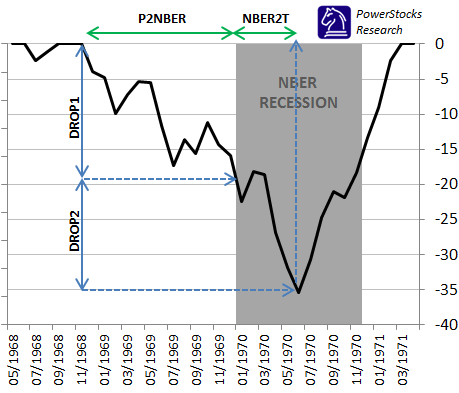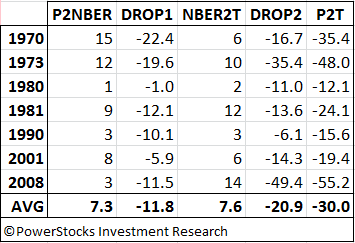At the end of September 2011, ECRI made a recession call which left the impression recession was imminent. With a track record like theirs there was very little challenging argument. Two days later, the S&P-500 bottomed and rose and incredible 22% since.
In December 2011, ECRI “dialled down” their call to “within 9 months”. Just how much recession warning is useful? It is understandable that long 10-12 month warnings would be useful for governments and some business leaders planning factory/infrastructure build-outs or acquisitions, but is this true for the stock market participant? How many thousands of investors heeded the recession call and are sitting in disbelief on the side-lines (or heavily hedged) in this rally wondering when the recession is going to arrive and vindicate their decisions?
Many analysts dismiss the usefulness of co-incident indicators in recession dating, with the notion that by the time you realize its recession with co-incident indicators, the horse has bolted. Therefore the use of leading-indicators is advocated and the longer the lead the better. This seems intuitive, but is it really true? We can be far more accurate in dating recession using short-leading and/or co-incident economic indicators but does this really add no value as common wisdom seems to dictate? Come to think of it – is it even really worth taking any defensive action with looming recession?
 Let us take a look at what history tells us in the 7 recessions going back to 1967 and we can answer these questions with some very surprising results. Before we proceed we need to frame the methodology and analytics we will present in the following chart depicting the very first recession under review in 1970:
Let us take a look at what history tells us in the 7 recessions going back to 1967 and we can answer these questions with some very surprising results. Before we proceed we need to frame the methodology and analytics we will present in the following chart depicting the very first recession under review in 1970:
For each recession we will examine % decline from recent high of the NYSE in relation to NBER dated recessions (defined as the month following the business cycle peak through to the trough) by a black line. We will measure 4 metrics, namely P2NBER (how many months elapsed from the NYSE peak to the 1st month of recession), DROP1 (how much % the NYSE declined in the P2NBER months), NBER2T (how many months elapsed from the 1st month of recession to the NYSE correction inter-recession trough) and DROP2 (how much % the NYSE declined from the 1st month of the recession to the NYSE inter-recession trough.)
The conventional wisdom tells us DROP1 will be much larger than DROP2 – the earlier your warning and the sooner you get out, the better.
The results of this exercise are tabled as follows:
 What jumps out is that the conventional wisdom held until 1973 and then underwent a dramatic change, with the stock market becoming much more timely in signalling recession as shown by the dramatic fall in the size of the months in the P2NBER column. We think the stock market and recession forecasting/dating techniques & models have become much more sophisticated to result in this fall in the “lead” between when the stock market peaks and onset of recession. If we include the 1970 and 1973 recessions, then the analysis tells us the stock market peaks 7.3 months on average before the onset of recession. But if we exclude these two recessions, the average almost halves to a mere 4.8 months with a 3 month standard deviation!
What jumps out is that the conventional wisdom held until 1973 and then underwent a dramatic change, with the stock market becoming much more timely in signalling recession as shown by the dramatic fall in the size of the months in the P2NBER column. We think the stock market and recession forecasting/dating techniques & models have become much more sophisticated to result in this fall in the “lead” between when the stock market peaks and onset of recession. If we include the 1970 and 1973 recessions, then the analysis tells us the stock market peaks 7.3 months on average before the onset of recession. But if we exclude these two recessions, the average almost halves to a mere 4.8 months with a 3 month standard deviation!
We can conclude that any defensive action longer than 4.8 months before recession is going to be counter-productive for the stock market participant. Think about this – it has been 5 months since ECRI’s recession call and the stock market has rallied more than 22% since. Is that counter-productive enough for you?
Now for the big surprise – DROP2 is much bigger than DROP1 – almost double! That hits most seasoned investors and clients we have revealed this to right between the eyes. Think about this carefully – if you use any number of well-crafted models that are based on coincident indicators (and there are brilliant ones out there, including some we have built) you are still likely to avoid two-thirds or more of any recession related correction (assuming of course you time the re-entry on stock market trough perfectly- but we have to assume the two methods will re-enter at the same time when evaluating optimal times to exit.) This stylized fact is not isolated – in 5 of the 7 recessions this was true and for the 2 it was not, DROP2 was not that far from DROP1.
Obviously, it is ideal to exit 4.8 months before recession (on average). BUT IT IS NOT CRUCIAL and arguably unless your leading indicator is dead accurate (which cannot be guaranteed) it is possibly NOT IDEAL unless it has a short lead.
Given the far higher dating accuracy one can achieve with statistical models deploying co-incident indicators, you ignore co-incident data at your peril. We say this as many respected leading economic indicators (the ECRI WLI being one) have been whip-sawed with false positives of late and one ought to be hesitant in basing high-stakes decisions-which is what acting on recession calls are-on purely leading indicators. Co-incident indicators reflect the REAL economic reality, whereas leading indicators PREDICT. Co-incident is always going to emerge the winner in the “measure the real outcome” contest. That is why statistical models for dating recessions using co-incident indicators are generally more ACCURATE in pinpointing exact start and end dates of recession. Hey, the NBER use a set of co-incident indicators to proclaim recession (a belated 8-12 months later), not leading ones, so it figures right?
Of course, co-incident indicators will never offer lead warning as leading indicators do. They were not designed to. But we are saying it is not such a huge deal, since their improved accuracy coupled with their “small” 1/3 loss of “efficiency” in a high-stakes game still makes them a player in any self-respecting recession model or approach.
Our composite SuperIndexes, which we used to offer an opposing view to the cacophony of recession calls in late December/early January deploys co-incident and leading indicators in various ways to offer recession forecasting and dating for this very reason. By all means use leading indicators, but be aware that risking an entire exit or hedging strategy based purely on leading indicators may not offer the best risk adjusted approach, since leading indicators CAN be whipsawed with false positives.
The Takeaways
- Heading for the hills more than 5 months before recession is more likely counter-productive than productive
- You need not isolate your decision points to LEI’s only
- They can be subject to false positives
- They only give you an extra 33% “edge”
- Couple or stage your actions with recession models using more accurate CEI’s to still capture 2/3 of the benefit

Comments are closed.